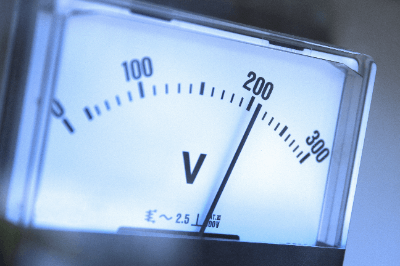What Is a Voltmeter?

A voltmeter is a device that measures the voltage between two points to be measured. They are mainly classified into digital and analog voltmeters. Digital voltmeters use an A/D converter to convert the input voltage to a digital value and display it numerically, enabling highly accurate measurements.
Analog voltmeters, on the other hand, are a combination of ammeters and voltage dividers and are characterized by the ability to determine the voltage value from the position of the meter pointer roughly. AC voltmeters usually convert alternating current to direct current using a rectifier circuit and measure and display the voltage. The measurement of distortion waves is less accurate than that of sine waves.
Uses of Voltmeters
Voltmeters are used in a wide variety of applications, including adjustment and inspection in production lines, monitoring the operating status of various facilities, and measuring temperature and humidity in combination with sensors.
Each model of voltmeter has a defined measurement voltage range, so it is necessary to select the appropriate model according to the purpose of use. Depending on the measurement target, the input impedance of the voltmeters may affect circuit operation, resulting in measurement errors, so careful consideration is required.
It is especially important to clarify the performance requirements of the voltmeters and select voltmeters that meet them, such as voltmeters with measurement accuracy, that is one order of magnitude higher than that required for accurate measurement.
Principle of Voltmeters
The operating principles of digital voltmeters and analog voltmeters are described below.
1. Digital Voltmeters
Digital voltmeters consist of an input converter, an A/D converter, and a display. The input converter consists of an amplifier and voltage divider to adjust the voltage to be measured between two points to an appropriate voltage within the input voltage range of the A/D converter.
In other words, the amplifier amplifies the measured voltage when it is small and the voltage divider divides the measured voltage when it is high so that the A/D converter can convert it to a digital value with high accuracy. The digital value converted by the A/D converter is displayed as a voltage value on the display after converting the effects of the amplifier and voltage divider.
Since the input impedance of the input converter can be set relatively high, the effect on the circuit to which the voltmeters are connected is small, enabling highly accurate voltage measurement.
2. Analog Voltmeters
Analog voltmeters consist of an ammeter and a voltage divider. When the probes of the voltmeter are connected to two points on either side of the circuit element to be measured, the current is obtained by dividing the voltage between the two points by the sum of the resistance of the voltage divider and the internal resistance of the ammeter flows into the ammeter. The meter pointer will oscillate according to the current value and show the voltage value obtained by multiplying the current value by the sum of the voltage divider resistance and the internal resistance of the ammeter.
The meter pointer can be read visually only about 1% of full scale, which is much less accurate than a digital voltmeter that can measure with an error of 0.1% or less. Ammeters used in analog voltmeters are mainly of the movable coil type using permanent magnets, but the movable iron strip type using electromagnets is also used in some applications. The movable iron strip type has the advantage of being able to measure the RMS value of the alternating current without a rectifier circuit.
How to Use Voltmeters
Voltmeters must be connected in parallel to the circuit under test to measure voltage. In the case of DC voltage measurement, by placing the Hi terminal probe on the high potential side and the Lo terminal probe on the low potential side, the Hi terminal voltage concerning the Lo terminal potential is displayed. With analog DC voltmeters, connecting the low potential side to the Hi terminal and the high potential side to the Lo terminal will drive the meter in the opposite direction and may break the meter, so be very careful.
On the other hand, when measuring AC voltage, both digital and analog voltmeters convert the voltage to DC voltage via a rectifier circuit, so there is no need to be aware of the Hi and Lo terminals. Analog voltmeters also require attention when measuring high voltages. If a voltage exceeding the measurement range is applied, not only will the meter pointer swing out of alignment, but the meter itself may burn out due to the large current flowing through it, or its fuse may blow, if a fuse is part of the voltmeter.
If the voltage value of the circuit to be measured is unknown, measure at the maximum voltage range to determine the appropriate measurement range, and then switch to that measurement range for a new measurement. Digital voltmeters are designed to withstand high voltages and are equipped with an auto-range function that automatically sets the appropriate range.